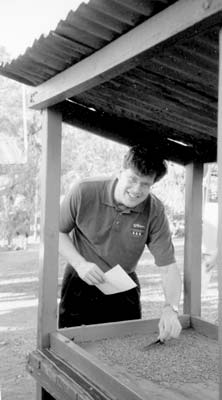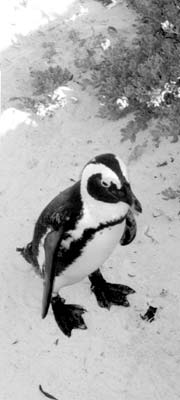You simply must visit South Africa
by Philip Wagenaar, second of three parts
Last month I discussed my travels in Johannesburg. This month I will continue my travelogue of South Africa.
The Blue Train
If you want to splurge, take the 25-hour journey on the Blue Train from Pretoria, a little north of Johannesburg, to Cape Town. (If you desire, you can continue on the Garden Route to Port Elizabeth.) This luxurious but expensive train ride, which was started in 1997, is a once-in-a-lifetime experience.
Before we even had a glimpse of the blue-colored train, the check-in at the elegantly appointed waiting room gave us a taste of what was to come. Beautifully attired girls, standing behind a curved blue counter, handed us our boarding passes while appetizingly arranged canapés and flutes of shimmering champagne anxiously awaited our eager hands.
After a porter guided us to our individual suites, where an attractive fruit plate exuded a gracious welcome, the butler arrived to explain the various cabin controls (such as the remote to operate the blinds) and the use of the cell phone to summon him.
The furniture in the luxuriously appointed suite consisted of an occasional chair for sitting at the table and two comfortable lounge chairs which converted to beds at night. A roomy wardrobe revealing a bathrobe and a safe, as well as a beautiful private bathroom with a large vanity of Italian marble, an ample shower (or bath) and a toilet, completed the accoutrements.
Lunch was an epicurean repast consisting of appetizer, soup, sole and dessert and as much wine as we desired, while dinner required elegant attire to complement the gastronomic meal with its choice of three entrées. At both, the service was impeccable and pleasant.
During the journey, we could watch the scenery through the panoramic windows of our suites or get a view of the tracks ahead of the train on our private TVs as if we were sitting in the driver’s seat. Alternatively, we could watch movies in our compartments or visit with our fellow travelers in the observation car.
Kimberley
In the late afternoon, the train stopped in the diamond city of Kimberley to give us the opportunity to visit the open-air Mine Museum and the Big Hole. The museum is a reconstruction of the town of Kimberley in the 1880s, complete with paved streets, stores, a miner’s cottage and a dentist’s office. An exhibit gives an idea of the huge diamonds found in the area.
The Big Hole, the world’s deepest man-made hole, is a dramatic pit 215 meters deep and 1.6 kilometers in circumference left by the more than 30,000 miners who, in 1871, started their explorations on the surface of Colesberg Koppie (later Kimberley) in a small area measuring 200 by 300 meters. Getting in each other’s way and realizing that diamonds also were available below the top, they continued their digging deeper and deeper, finally leaving the hole when the mine was closed.
It is now partially filled with water. An elaborate system of checks prevents the water from rising too high, averting a second collapse of Kimberley’s streets (the first one happened a number of years ago).
Upon entering the grounds, everybody received a certificate (granting permission to the bearer to dig for diamonds), a bucket of dirt and a small shovel. If we found anything that glittered, although it most likely would not be a diamond, we would receive a prize.
During the tour of the museum, our guide explained that the term karat (also spelled carat), the unit measure for diamonds and equal to 200 milligrams, derives from Ceratonia siliqua, the Greek name of the carob tree. Initially, since its seeds are always the same size and weight when ripe, diamonds were counterweighed against them.
Diamond sorting takes place in a tall building dominating Kimberley’s skyline. Since grading of the precious stones is never done in artificial illumination, the windows have been placed in a position to optimize the entrance of natural daylight.
The cost of the Blue Train suite runs between 15,895 and 17,765 rand ($2,001-$2,220), double, depending upon the season, including all meals, high tea, snacks, wine and drinks to your heart’s (or brain’s) content.
The train leaves from both Cape Town and Pretoria on Mondays, Wednesdays and Fridays.
You can contact the Central Reservation Office for the Blue Train in South Africa (phone 011/27/12 334-8459, fax 011/27/12 334-8464, e-mail bluetrain@transnet.co.za or visit www.bluetrain.co.za). . . or you can contact their U.S. representative, Tim Farrell & Associates (P.O. Box 7300, Wilton CT 06897-7300; phone 203/762-8050, fax 203/762-7323 or e-mail safaritim@aol.com).
Cape Town
Although this was my third trip to Cape Town, I found the city still captivating.
The stunning view from my room at the 5-star Table Bay Hotel, overlooking the waterfront with its myriad colorful ships and with Table Mountain in the background, was beyond words.
Be sure to stroll around the perfectly safe Victoria & Alfred Waterfront with its shimmering harbor, its many piers, hotels and restaurants and its beautiful marble-floored malls.
Visit 1,000-meter-high Table Mountain, which dominates the skyline. Go up by cable car early in the morning. Do take warm clothes, as the weather can change rapidly, obscuring the mountain with a cloud (called “the tablecloth”) so dense that you may completely lose your orientation. Once on top, when conditions permit, absorb the fabulous views and hike the easy trails.
Drive along False Bay via Fishhoek and its lovely beach, where South Africans go for their summer vacation, and stop at Boulders Beach to see the colony of 3,000 lovely, wonderful, waddling African penguins.
Continue to the fantastic scenery of the Cape of Good Hope Nature Reserve (part of Cape Peninsula National Park). Park your car at Cape Point, the end of the road. From there, take the funicular or walk to the old lighthouse, pitched high above the water, to savor the incredible panorama of Cape Town.
Watch out for Cape Point’s very aggressive baboons. On our group’s recent visit, a monkey grabbed a woman’s cosmetic bag and frantically tried to open the zipper with his mouth. The woman was also determined. She tried to pull the case away from the monkey, which, visibly upset, punched her in the abdomen. Realizing she had to outwit him, she threw a piece of bread on the ground, whereupon he promptly released her bag.
To go to the actual Cape of Good Hope, the southwesternmost point of Africa, return the way you came. A turnoff to the left takes you down to a small promontory with crashing waves where a sign proclaims, “Cape of Good Hope.” It is generally perceived as the meeting place of the Atlantic and Indian oceans. Geographically, however, the Indian Ocean joins the Atlantic at Cape Agulhas farther east.
Rounding out your visit
Be sure to drive back to Cape Town along the M65 via Kommetjie and the M6 via Hout Bay and feast your eyes on the gorgeous mansions overlooking the Atlantic Ocean.
Just across the road from upscale Hout Bay, visit the jumbled township of Imizamo Yethu with its atrocious housing. (Green Turtle Tours & Safaris offers a tour through the community. Phone 011/27/82/558-2963 or 011/27/82 882-7884 or e-mail grturtle@mweb.co.za.)
Alternatively, if you’re unable to visit Imizamo Yethu, drive on the N2 freeway past the Cape Flats, a district full of sprawling townships where abominable conditions still exist, although the government has provided two million concrete homes. (Because of the high crime rate, it is dangerous to go inside the Cape Flats.)
You might have dinner at the Africa Café (108 Shortmarket St., Cape Town 8001, South Africa; phone 011/27/21 422-0221, e-mail africafe@iafrica.co or visit www. africacafe.co.za), where waitresses in traditional African dresses and striking headgear serve a sumptuous panoply of dishes from a set menu at a cost of between 125 and 160 rand ($16-$20).
Enjoy a delightful buffet lunch at the upmarket Steenberg Hotel (10802 Steenberg Estate, Tokai Road Tokai, 7945, South Africa; phone 011/27/21 713-2222, fax 011/27/21 713-2251, e-mail reservations@steenberghotel.com or visit www. steenberghotel.com), a working wine farm in the Constantia Valley lying on the slope of Steenberg Mountain and offering sweeping views over False Bay. You also may want to stay at this luxury boutique hotel which dates back to 1682. The buildings were restored and have been declared a national monument. All rooms overlook the vineyards or manicured gardens. Well-marked trails in the area invite you to go hiking.
Last, but not least, be sure to sample the many varieties of fish offered in Cape Town’s restaurants.
For more information about Cape Town, visit www.cape-town.org.
Next month, I will continue with information about South Africa’s wine country and the Garden Route and offer suggestions for exploring other areas of South Africa.
Philip Wagenaar was a guest of South African Tourism and South African Airways.



